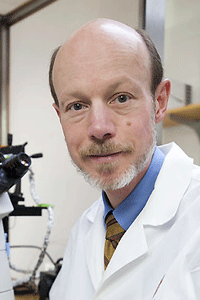
Education
- BS, University of Notre Dame
- PhD, Pharmacological Sciences and Physiological Sciences, University of Chicago
- MD, University of Chicago
Research Description
Cardiac ion channels and embryonic stem cell-derived cardiomyocytes
1. Cardiovascular Calcium Channels Function, Structure and Regulation: Cardiac Ca2+ channels play an important role in cellular excitability by allowing the rapid influx of Ca which depolarizes the cell. The resulting increase in intracellular [Ca2+] is essential for regulation of Ca2+-dependent processes including excitation-contraction coupling, excitation- secretion coupling, and gene regulation. Current research focuses on defining the exact subunit composition of the channel in the heart and determining the molecular mechanisms of regulation of this channel complex. A variety of molecular biology, cellular electrophysiology, biochemical, and pharmacological approaches are employed in these studies which are currently evaluating the role of PKA and PKC pathways regulating the channel. Several lines of conditional knockout mice have been generated to facilitate these studies.
2. Remodeling of Cardiomyocytes and Excitation-Contraction Coupling in Heart Failure: In congestive heart failure there are fundamental abnormalities in excitation-contraction coupling at the cellular level which remain poorly understood. We have recently demonstrated a striking depletion of the T-tubule network in failing myocytes using confocal microscopy. As T-tubules are normally the major site of excitation-contraction coupling in ventricular myocytes, this remodeling of failing myocytes has important functional impact. Ongoing studies are exploring the changes in membrane proteins associated with this cellular remodeling and the effect on excitation-contraction coupling using a variety of animal models and tissue from explanted human hearts.
3. Isolation and Characterization of Human Embryonic Stem Cell-Derived Cardiomyocytes: Embryonic stem (ES) cells are pluripotent cells capable of developing into specific cell types of all three germ layers including cardiomyocytes. The last ten years have seen extensive efforts to characterize in vitro murine ES cell-derived cardiomyocytes; however, little is known about the ability of human ES cells to differentiate into cardiomyocytes. Our initial work with human ES cells has demonstrated that these cells can form spontaneously contracting embryoid bodies. Therefore, human ES cells can form cardiomyocytes, but the process of differentiation and the properties of those cardiomyocytes will have important differences with the murine ES-derived cardiomyocytes. The purpose of the present research is to optimize the differentiation of human ES cells into cardiomyocytes and to characterize the resulting cardiomyocytes. Ultimately, these cells will have tremendous potential for cell-based therapies for a variety of heart diseases. In addition, they will provide a useful cell culture model for a variety of basic research studies.
Honors
- 1998 UW Cardiovascular Research Center Heart Failure Research Award
- 1996 Howard Huges Postdoctoral Fellowship for Physicians
